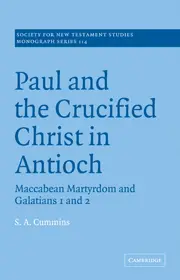

Paul and the Crucified Christ in Antioch: Maccabean Martyrdom and Galatians 1 and 2
in Society for New Testament Studies Monograph Series
Pages
306
Publisher
Cambridge University Press
Published
11/26/2001
ISBN-13
9780521662017
The so-called "Antioch Incident"--the confrontation between the apostles Peter and Paul recorded in Galatians 2.11-21--continues to be a source of controversy in scholarly as well as popular estimations of the emerging early church. This innovative interpretation of the event argues that the central issue at stake in Antioch--whether the Torah or Jesus Christ determines who are the people of God--gains great clarity and force when viewed in relation to a form of Judaism knows as Maccabean martyr theology.
Reviews
This Oxford University dissertation (directed by N. T. Wright) interprets the Antiochincident within the framework of Maccabean martyrdom. Cummins argues that both thehistorical and theological significance of the Antioch incident are clarified when viewedthrough this lens. His argument is not simply that Paul conformed his literarypresentation of the Antioch incident to this model but that Paul developed his self-understanding through the image of the Maccabean martyr. The study is divided into twoparts: the first investigates the image of the Maccabean martyr; the second examinesunderstandings of Paul and Christ in Antioch.In the first section Cummins argues, relying largely on 2 Maccabees, that the themes ofthe suffering and vindication of Israel came into sharpest focus around martyr stories.Since martyrs were willing to remain faithful and suffer for God and for the benefit ofGod’s people Israel; their suffering was efficacious for Israel. Through their blood Godacted to preserve Judaism and reestablish the covenant with Israel. Cummins furtherargues that there was “a widespread and coherent Jewish messianism” (39) in SecondTemple Judaism that was associated with the “one like a son of man” in Dan 7. Withinthis stream of expectation, this son of man often served as redeemer and ruler.
[Full Review]
